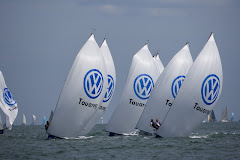Article by Chuck Allen: Sailing World
I've tested many sailboats while involved with Sailing World's Boat of the Year program and one of the coolest I've ever encountered is the Laser SB3. The absolute simplicity of this boat is amazing. Upwind it locks into a groove, which in most boats you have to fight to maintain. Downwind is a dream; the SB3 is an incredibly stable platform with remarkable speed.
Since its introduction in Europe in 2004, the SB3 has experienced tremendous growth, with more than 400 boats built. Two reasons for its popularity are that the boat has been designed to be sailed legs-in and all the controls are at the crew's fingertips. Another key feature is that it can be rigged and launched in 45 minutes. The mast is light enough to make raising it a two-man job, allowing the third, and possibly fourth crewmember to rig the rest of the boat. The T-bulb keel, which is raised and lowered by an included, removable gantry, makes launching and hauling painless. As the boat only weighs 1,309 pounds, a mid-sized car can tow it.
We sailed the SB3 twice, in 2 to 7 knots of breeze, and again in 25. Both times the SB3 found its groove easily and we found it nearly impossible to unintentionally slow down or fall off a plane. We tested moving our weight around, with the boat responding as expected. Light air and flat water required moving the crew forward and sitting close together, while in breeze and chop we moved aft. The boat sailed best in the light stuff with a lot of twist, and the long throw of the traveler made this easy; you can pull the car well to windward while easing the mainsheet for power. It was the exact opposite when the breeze was up; vang on, find the correct mainsheet tension and play the traveler up and down to control the angle of heel while maintaining good drive forward. All the controls are easily within reach and if someone needed to jump in to adjust a line, it wasn't a big deal. You think the boat is going to tip over like a dinghy, but the high-aspect keel underneath keeps it on its feet. The boat has a great feeling upwind and because of the flared gunwales, is relatively dry.
Downwind is an absolute blast; simply put, the SB3 rips! During our high-wind test we sailed consistently at around 15 to 18 knots of boatspeed. I would think when setting the 495-square foot kite at the offset in big fleets you would need to stay high, so easing the vang is a smart idea. When the kite reaches the sheave, it's take-off time. Weight aft near the foot straps is the place to be. When driving in breeze, the helmsman is butted up against the backstay, the kite trimmer next forward (using the foot straps), and the bow person is the furthest forward, watching the vang while pumping the main. It's quite obvious when a puff hits that you need to bear down a bit. Once you do so, the boatspeed jumps a couple of knots. A breeze spotter is the way to go, and can make a huge difference in one-design racing in a boat like this.
Jibing is simple, especially with the long pole and high-clewed gennaker. I found the easiest way is to start the jibe slowly, wait until the clew got just past the centerline, and finish on the stronger side, coming out fully powered up. By starting slowly it also gives the crew some time to locate their position on the opposite side of the boat before take off. Sets and takedowns are very simple; there's an enormous launching bag at the forward edge of the cockpit. Takedowns require a quick turn downwind to help the bow person get the kite in the boat completely. Overall, downwind sailing in the SB3 will be some of the best sailing you'll ever do.
The SB3 hull laminate is epoxy with a foam core, and there's an internal frame and bulkheads providing strength and rigidity. The mast is an aluminum deck-stepped Proctor Selden rig with double spreaders. The boom, also by Proctor Selden, is aluminum as well, but the retractable pole is carbon fiber. The boat is mostly Harken equipped, with gear from the Carbo Block and Hexaratchet range. A Spinlock halyard cleating system offers easy lock and release even under load. The rudder is epoxy and core with carbon reinforcement, and the high-aspect ratio keel is based on a stainless steel main member with an epoxy, foam core, polyester skin, and a 770-pound lead bulb.
The best thing the SB3 class has done is put a tight rein on its rules. The boats come complete from bow to stern and you cannot change anything. This ensures tight racing and keeps running costs down. One potential cost issue could be sail purchasing, which is unlimited [but sails are only available from Hyde Sails through Laser]. In Europe the top sailors are showing up with new sails for each big event. Otherwise, you are looking at a $39,000 program (includes sails, trailer, and a TackTick system), which seems high at first, but when you look at comparable boats and their costs, it's right in line, if not better.
The SB3 was clearly the best boat we sailed this year; if not the best boat we have sailed in all our BOTY years. With the buzz over the SB3 in Europe, it seems poised to take the U.S. market by storm. If you get the chance to take one for a sail, go for it; you'll quickly see why we named the SB3 as our top choice.
For more information see link: http://www.sailingworld.com/sailboats/boat-of-the-year/2008-boat-of-the-year-coverage-21031640.html
Subscribe to:
Post Comments (Atom)


No comments:
Post a Comment